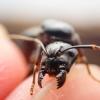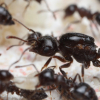Greetings everyone, my name is Garrett, and i'd like to share some data I have collected on Atta texana founding rates to illustrate to other keepers some of the most ideal ways to successfully found colonies. I am currently writing a publication involving some of this data, but below is Data from some of my trials this year.
Without Fungus Boost Without Fungus Boost Without Fungus Boost Single (A) Double (
I grouped queens into singles, doubles and 3-5. If a queen died in a single setup it was deemed as a failed trial, if a queen died in a double or 3-5 grouping, the data remained in the group they were established in. example, in a double setup if a queen died, the data recorded would remain in the double setup column(Y) instead of moving to the single queen data.
The results are conclusive and if you have donor fungus and a large group of queens, you can most certainly establish colonies. There are many other variables that must be accounted for such as temperature and humidity, substrate and also queen size.
The larger the queen the greater her likelihood of succeeding is. Let me know if you guys have any questions!

















